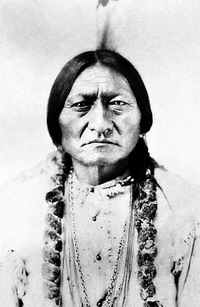Login form
Sitting Bull

Sitting Bull was already a skilled hunter and warrior in his early teens. When he was growing up, he never dreamed that he would be fighting for his way of life.
HOW DID HE GET HIS NAME?
Sitting Bull was born in about 1831 near the Grand River in South Dakota. He became a chief of the Sioux Indians at the age of 22. His name refers to a male buffalo, an animal that Native Americans believed to be strong and fearless. A sitting bull is stubborn as well. Sitting Bull received this name after he showed bravery and daring in an attack.
WHY DID HE GO ON THE ATTACK?
During the 1850s, Sitting Bull fought against other Native American groups. He avoided conflicts with white soldiers and settlers. But he changed his mind after the United States Army tried to force Sioux peoples in Minnesota to live on a reservation. Many Sioux fought back and were killed. Sitting Bull then led his warriors in a fierce defense of their lands. During the 1860s and 1870s, he attacked Army scouts, settlers, and prospectors who moved into Sioux land.
In June 1876, Sitting Bull had a vision. He saw soldiers falling dead. Later that month, he and another Sioux chief named Crazy Horse defeated U.S. Army troops. They wiped out Lieutenant Colonel George Armstrong Custer and his soldiers at the Battle of the Little Bighorn in Montana. Sitting Bull was always admired by his people. After his vision of soldiers dying came true, the Sioux believed in his power to tell the future.
HOW DID HIS VICTORY TURN TO DEFEAT?
Sitting Bull’s victory in the Battle of the Little Bighorn led to his defeat later on. The U.S. Army decided to force the Sioux onto reservations. Sitting Bull and his followers escaped to Canada. In 1881, however, they returned to the United States and surrendered. Sitting Bull was held as a prisoner for two years. Afterward he lived on the Standing Rock Reservation in North Dakota. During 1885 and 1886, he traveled with Buffalo Bill’s Wild West Show.
In 1890, Sitting Bull invited several Ghost dancers to the reservation. The Ghost Dance was a religious ritual. Those who believed in it thought it would bring back the old way of life. The police on the reservation feared an uprising and had Sitting Bull arrested. A gunfight broke out between Sitting Bull’s followers and the police. Sitting Bull and 12 others were killed on December 15, 1890.
Source: Microsoft ® Encarta

